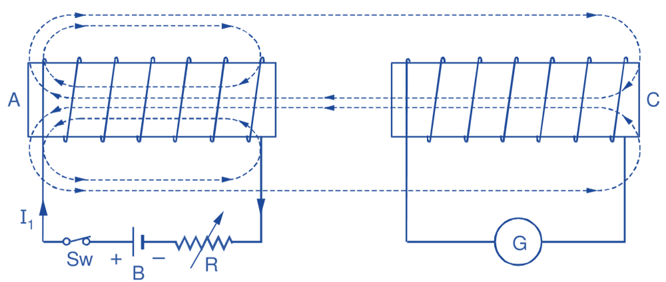In this topic, you study Mutual Inductance.
Mutual inductance may, therefore, be defined as the property due to which one coil (or circuit) with the change in its own current produces an e.m.f. in a nearby coil b induction.
Consider two coils A and C placed side by side as shown in Fig. 1. The coil A is connected in series with a switch (Sw), a battery (B) and a variable resistor (R). A sensitive galvanometer (G) is connected across the coil C.

Fig. 1: Mutual induction
On closing the switch, let the current flowing in the coil A be I1 amperes. Due to this current, the coil A will have its own flux. Some of the flux produced by this coil will link with the coil C. If now, the current in the coil A is changed by varying R, it will change the flux linking with the coil C.
According to Faraday’s law, this changing flux linking with the coil C will induce an e.m.f. in it. The production of the e.m.f. will be indicated by the deflection of the galvanometer. Thus, any change of the current in the coil A will produce an e.m.f. in the neighboring coil C. This phenomenon is known as mutual induction. The e.m.f. induced in the coil C in this manner is known as mutually induced e.m.f. or an e.m.f. of mutual induction. The most important example of an appliance working on the principle of mutual induction is transformer which is a static device used for changing the magnitude of an alternating voltage. The two magnetically coupled coils A and C in the above mentioned are said to have mutual inductance.